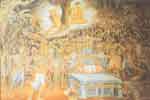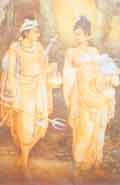|
Gaveshaka
relates the tale of Kelani Vihare Kelaniya has a long history going back to the days of the Buddha. It is recorded that the Buddha visited Kelaniya in the eighth year after His Enlightenment accompanied by five hundred Arahats, on the invitation of Maniakhkhika, the Naga king. It was on this visit that the Buddha set His footprint at Samanala Kanda, now venerated by the Buddhists the world over who climb Sri Pada and pay homage. The most talked about paintings are the ones, which are in two image houses - one known as the ‘Aluth Vihara’ and the other as ‘Ran Pilima Ge’. They are creations of the talented artist, Soliyas Mendis and have been done during the period 1932 to 1946. His is a style different to both the Kandyan and low country traditions.
The arrival of Theri Sanghamitta with the Sri Maha Bodhi, the bringing of the Sacred Tooth Relic by Princess Hemamali, and the handing over of the Act of Appointment to Velivita Sri Sangharaja Thera by King Kirti Sri Rajasinghe are depicted in the other three. Now let us discuss the history of Kelaniya briefly. Kelaniya temple is on the banks of the Kelani Ganga, which starts from Sri Pada and flows down to the sea in Colombo. The village near the river was known as ‘Kelani Gama’ and ‘Kelani Puraya’ - the city of Kelani. It was customary in ancient times for settlements to be built around rivers. People settled down in places where they could get water for their agricultural pursuits. The river could be used for transport purposes too using traditional ‘oru’ and ‘paaru’. It is also possible that Kelaniya was used as a port to transport goods. Kelaniya temple is reputed for a distinguished generation of Buddhist monks during their Kotte kingdom. They received royal patronage from King Parakramabahu VI and King Bhuvaneka Bahu VI. Because of the respect they had gained as devoted members of the Maha Sangha, they were approached by the Burmese king to conduct the Upasampada or higher ordination ceremony. The request was made through the King of Kotte and was accepted. This was in 1475. Forty four monks arrived from Burma and the ceremony was arranged in the middle of the Kelani Ganga on the exact spot where the Buddha bathed. The three-day ceremony was performed to the satisfaction of everyone who participated, and the king of Burma was very pleased and sent gifts as a mark of appreciation. Kelaniya temple was completely destroyed by the Portuguese, who, it was said, used the temple bricks to build a fort in Colombo city. This was done after Don Juan Dharmapala became a convert and handed over Kelaniya temple to the Portuguese in 1591. The Dutch, who took over the maritime provinces from the Portuguese, issued an order in 1682 banning the practice of Buddhism. Things gradually changed after the British took over. |
||||
Copyright © 2001 Wijeya Newspapers
Ltd. All rights reserved. |
 Among
the Raja Maha Viharas which received the patronage of the Sinhalese
kings, Kelaniya close to the capital city of Colombo is quite famous.
Just as much as it a temple of historical importance, Kelaniya has
some of the finest paintings of much more recent origin than those
found in other temples.
Among
the Raja Maha Viharas which received the patronage of the Sinhalese
kings, Kelaniya close to the capital city of Colombo is quite famous.
Just as much as it a temple of historical importance, Kelaniya has
some of the finest paintings of much more recent origin than those
found in other temples.  The
Kelaniya vihare had been renovated in 1888 by Mrs Helena Wijewardena.
The oldest paintings are seen in this vihara, known as ‘Raja
Pilima Ge’. The paintings depict scenes from the Buddha’s
life and history of Buddhism as well as a few Jataka tales. The
‘Solosmasthana’ - the sixteen sacred places of worship
hallowed by the Buddha are seen on one wall. In another image house
known as ‘Oth Pilima Ge’, the reclining Buddha is accepted
as one belonging to the Kandyan period.
The
Kelaniya vihare had been renovated in 1888 by Mrs Helena Wijewardena.
The oldest paintings are seen in this vihara, known as ‘Raja
Pilima Ge’. The paintings depict scenes from the Buddha’s
life and history of Buddhism as well as a few Jataka tales. The
‘Solosmasthana’ - the sixteen sacred places of worship
hallowed by the Buddha are seen on one wall. In another image house
known as ‘Oth Pilima Ge’, the reclining Buddha is accepted
as one belonging to the Kandyan period. All
four walls in the ‘Aluth Vihara’ contain murals relating
the history of Buddhism in Sri Lanka. A golden statue in the backdrop
of the Himalayan mountain covered with snow greets the visitor to
the ‘Ran Pilima Ge’ and creates a deep sense of devotion.
Four big murals in this image house stand out. One shows the learned
monk, Buddhagosha Thera handing over the Visuddhimagga, a valuable
text, written by him to the Sangharaja. He had arrived from India
at the famous Mahavihara in Anuradhapura.
All
four walls in the ‘Aluth Vihara’ contain murals relating
the history of Buddhism in Sri Lanka. A golden statue in the backdrop
of the Himalayan mountain covered with snow greets the visitor to
the ‘Ran Pilima Ge’ and creates a deep sense of devotion.
Four big murals in this image house stand out. One shows the learned
monk, Buddhagosha Thera handing over the Visuddhimagga, a valuable
text, written by him to the Sangharaja. He had arrived from India
at the famous Mahavihara in Anuradhapura.